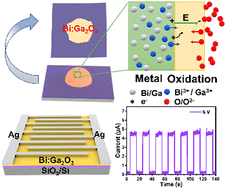Liquid metal-based printing synthesis of bismuth-doped gallium oxide and its application for a photodetector†
Abstract
Two-dimensional gallium oxide (Ga2O3) is a promising material with diverse applications, but its development and application are hindered by the complicated synthesis process of 2D Ga2O3 film. However, the van der Waals printing method, which employs liquid metal as a platform, can simply synthesize large-scale and high-quality 2D oxide films with ease. Moreover, the band structure of oxide films can be modulated through doping during the printing process, broadening their applications. In this study, pure and doped Ga2O3 films have been successfully synthesized by using Bi–Ga alloys with different ratios (0 wt% Bi, 1 wt% Bi, 10 wt% Bi, 15 wt% Bi) via the van der Waals printing method. Furthermore, the modulation of the band structure of Ga2O3 films by doping ranging from 5.23 eV to 4.88 eV is systematically investigated. Photodetectors based on Ga2O3 films with a controllable band structure have been fabricated, which demonstrated good sensing performance with a responsivity of 959 mA W−1, detectivity of 3.43 × 1011 Jones, and response/recovery time of 13 ms/18 ms. This printing method provides a straightforward, low-cost, and high-efficiency strategy for synthesizing and doping 2D oxide films, which could advance their practical applications.



 Please wait while we load your content...
Please wait while we load your content...